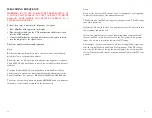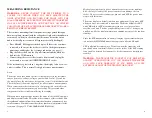
6
MEASURING RESISTANCE
WARNINGS:
NEVER CONNECT THE TEST PROBES TO A
SOURCE OF VOLTAGE WHEN YOU HAVE SELECTED THE
OHMS FUNCTION AND PLUGGED THE LEADS INTO THE
/
.
mA TERMINAL. BE SURE THAT THE CIRCUIT UNDER TEST
HAS ALL POWER REMOVED AND THAT ANY ASSOCIATED
CAPACITORS ARE FULLY DISCHARGED BEFORE YOU MAKE A
RESISTANCE MEASUREMENT.
The resistance measuring circuit compares the voltage gained through a
known resistance (internal) with the voltage developed across the unknown
resistance. So, when you check in circuit resistance, be sure the circuit
under test has all power removed (all capacitors are fully discharged).
• Press
/
CONT
. M appears in the display. If there is no resistance
connected to the meter, the meter sets itself to the highest measure-
ment range and displays the overrange indication
(see page 3).
• Plug the red test lead into the /
.
mA terminal and the black test
lead into the COM terminal.
• Connect the probes across the circuit to be measured or plug the
resistor under test into the OHMS/DIODE/CAP socket.
If the resistance is greater than 1 megohm, the display takes a few sec-
onds to stabilize. This is normal for high-resistance measurements.
Notes:
The meter has a fuse and a special circuit that protects the resistance
ranges from over-voltage (voltages greater than 5 volts). If you blow
the meter's fuse, the meter does not operate correctly in the ohms mode.
Check the fuse if the meter displays 0 for all resistance measurements.
When you measure the resistance of a component in a circuit, discon-
nect one side of the component you are testing. This prevents other
components in the circuit from affecting the reading.
When you touch the probe ends together, the meter selects the 400-ohm scale
and displays a small value. This value is the resistance of the test leads. Note
this value and subtract it from the measured value when you measure a very
small resistance. You can also use the relative function to compensate for the
resistance. (See page 15,
U
SING
THE
R
ELATIVE
F
UNCTION
.
)
11
High-voltage junctions in power transistors prevent correct readings.
Also, the larger leads of the power transistor can damage the test
socket. Do not try to determine type, pin out, and hFE for power tran-
sistors with this meter.
The meter displays a default junction type and pinout if you press hFE
when you have not connected a transistor. The meter defaults to PNP
and CEB with the hFE measurement given as a very large value or
overflow condition. The bar graph reading is not stable – it ranges up
and down while the display maintains a running average of the random
readings.
Since the hFE measurement is an auto-ranging type measurement, you
cannot use the MIN/MAX and relative options while in hFE mode.
hFE is affected by temperature. Try not to warm the transistor with
your hand when you install the device in the socket. If the hFE reading
is not stable when you first measure it, let the transistor's temperature
stabilize.
WARNING:
THE TRANSISTOR SOCKET IS NOT PROTECTED
AGAINST OVER-VOLTAGE. YOU CAN DAMAGE THE METER
AND VOID YOUR WARRANTY IF YOU BUILD AND USE
EXTERNAL LEADS FOR THE TRANSISTOR SOCKET.


























